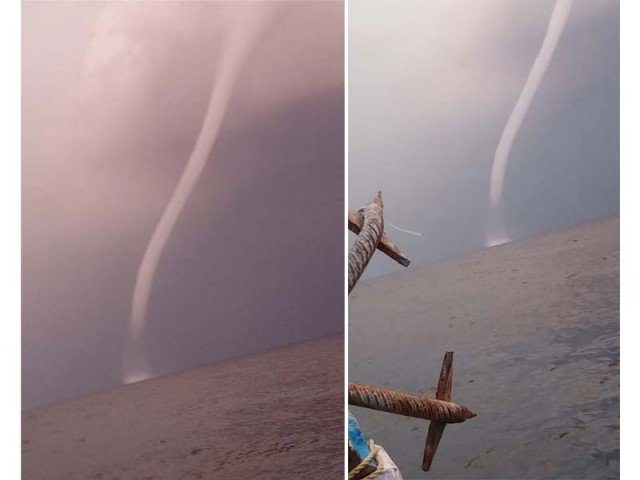A WWF-Pakistan trained fisherman operating in the offshore waters of Pakistan reported the occurrence of a waterspout on 21 January 2019.
This rare weather phenomenon was reported by Captain Saeed Zaman who was fishing for tuna about 57 nautical miles from the coastline in offshore waters at Ghora Bari, Sindh coast. He recorded this spectacular waterspout which looked similar to a tornado. This rare weather phenomenon was previously reported by fishermen on 28 February 2016 near Sakoni (off Kalmat Khor), Balochistan.
According to Saeed Zaman, this massive waterspout was coming towards his boat but he managed to move away from it. He shared that he observed a large patch of cloud on the morning of 22 January from which the waterspout could be seen descending. Other fishing boats operating in the area also observed this massive waterspout but they also avoided approaching it.
Contrary to its name, a waterspout is not filled with water but is a column of cloud-filled wind rotating over the ocean's surface. It descends from a cumulus cloud and the water inside a waterspout is formed by condensation in the cloud.
There are two types of waterspouts i.e. tornadic and fair-weather. The clouds from which waterspouts descend are not fast-moving, so fair-weather waterspouts are often static. Both waterspouts require high levels of humidity and a relatively warm water temperature compared to the overlying air. Waterspouts are most common in tropical and subtropical waters but this is the second authentic record of its occurrence from Pakistan coast.
According to Muhammad Moazzam Khan, Technical Advisor (Marine Fisheries), WWF-Pakistan, waterspouts are usually formed along the cumulus type of clouds. This type of waterspout is generally not associated with thunderstorms which usually dissipate in short time. Waterspouts have long been recognized as serious marine hazards. Stronger waterspouts pose threat to small boats. It is recommended that fishers keep a considerable distance from such phenomena. The average spout is around 50 metres in diameter, with wind speeds of 80 kilometres per hour. 'Most waterspouts last for up to one hour, though the average lifetime is just 5 to 10 minutes', he added.
The formation of a waterspout takes place over five stages; the first stage is the formation of a disk on the surface of water, known as a dark spot; the second stage is a spiral pattern on the water surface; the third stage is a formation of a spray ring; the fourth stage is where the waterspout becomes a visible funnel; and the lifecycle ends and fifth stage where the waterspout decays.
WWF-Pakistan appreciated the alertness and vision of the fishermen who have been trained to record such rare events including release of endangered marine animals.

Reader Comments
to our Newsletter